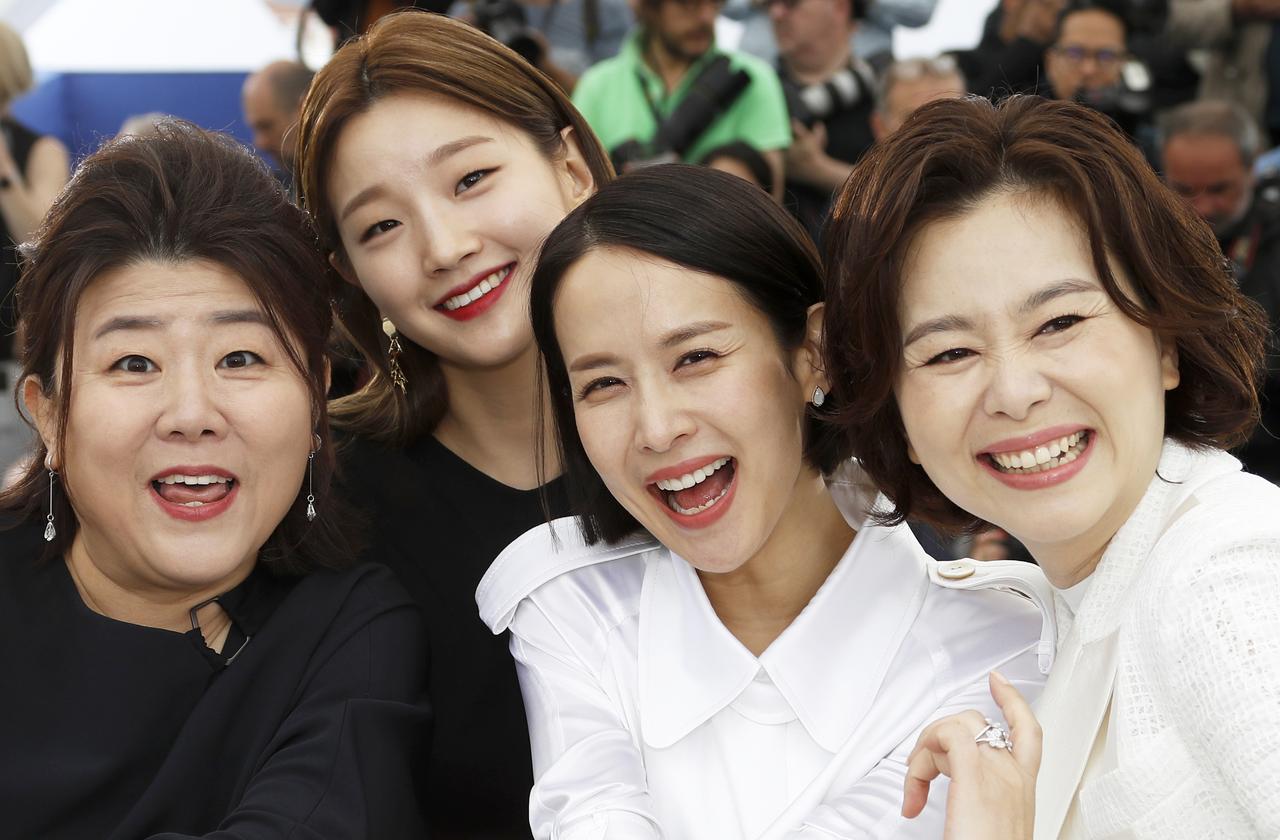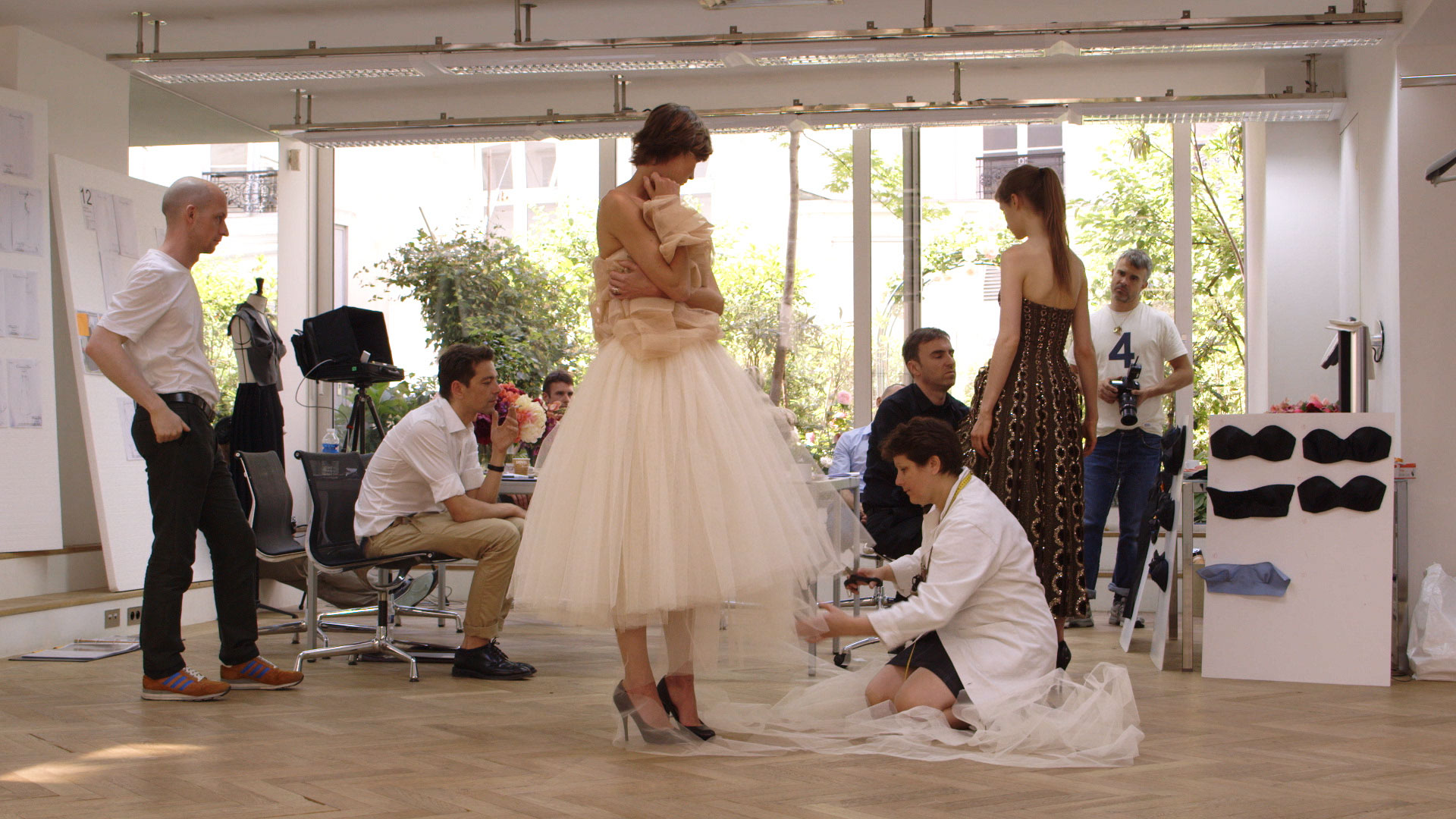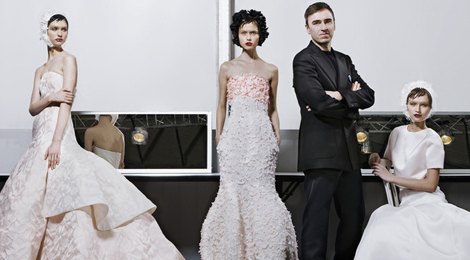Interview: "Dior and I" Director. Film and Fashion Are More Connected Than You'd Think
 Friday, April 10, 2015 at 11:21AM
Friday, April 10, 2015 at 11:21AM  Jose here to bring you and interview as the new documentary Dior and I opens in select theaters.
Jose here to bring you and interview as the new documentary Dior and I opens in select theaters.
In April 2012, Raf Simons was announced as the new creative director at Christian Dior, fashion experts all over the world were surprised that they’d chosen a minimalist Belgian designer who up to then had mostly been known for his menswear, and when his first couture collection debuted, the house of Dior was once again giving people something to talk about, as Simons sought to pay tribute to the man whose “New Look” revolutionized fashion in the twentieth century. What few people knew was the behind-the-scenes drama that had the introverted Simons become the hero at the center of a thriller which had him try to deliver a couture collection in two months, as opposed to the six most designers are given to work with.
In his provocative documentary Dior and I, director Frédéric Tcheng gives us access to this exclusive world in which art and commerce are at constant odds with each other. Tcheng has amassed an admirable nonfiction filmography comprised of some of the greatest fashion films in recent years, he co-produced and edited the Oscar short-listed Valentino: The Last Emperor and co-directed the delicious Diana Vreeland: The Eye Has to Travel, but as he explained during our chat in New York City, he’s not interested in being “a fashion filmmaker”, but instead wants to tell compelling stories that transcend into the universal.
THE INTERVIEW
JOSE: Something that never becomes clear in the film is why he would agree to do the collection in eight weeks? Did you ask him about this?
FRÉDÉRIC TCHENG: (Laughs) I think the timing just happened to be that way, I’m not sure what was actually said at the meetings when they were negotiating his arrival, so I can’t speak for that. What I gather is that Dior wanted him to start with couture as a statement, not ready to wear, but couture, which happens only twice a year. Everyone was waiting for Dior to announce a new designer, and it took them almost a year to do it, so I don’t know what happened in those meeting rooms.
This time element gave you the tools to make a thriller! [More...]

FRÉDÉRIC TCHENG: I know, for me it was godsent in a way! I don’t know what went wrong in their ends, but also this was also a challenge for me, because they had eight weeks and I only had eight weeks to make a 90 minute film. It takes a lot of footage to make a movie that I would be happy with, so I was stressed too, I wasn’t sure if I would have enough to make a movie. It felt like a thriller being there too, I woke up every morning not knowing what would happen and whether I would be able to capture it or not.
The title of the film works on two levels, it’s Dior and I because it’s about Christian and Raf, but it’s also a film about you and Dior.
I’ve never really liked documentaries where the filmmakers put themselves into the story, it’s not something that I’d want to do, but I realized I’d done it unconsciously by telling a story of the creative process, which also involved my own creative process. The reason I was able to relate to the story was because I was going through a very similar experience, so the parallels between film and fashion became very evident. The original title of the film was My Dior, which you can see in the film in a video playing in the windows in a very Gertrude Stein kind of statement, it resonated with me because it was about the personal bond a creator has with their creation. It turns out that My Dior is a jewelry line, so for copyright reasons it was hard to use it for the title of our film, so Dior and I captured what we were trying to say in an even better way, because it captured the essence of Christian’s autobiography and also some of Borges’ writing.
I want to touch more on the similarities between film and fashion, because watching the film with a friend, he asked me why were all the head seamstresses women and the only explanation I could think of, was that fashion houses are still run like old Hollywood studios in which women worked as editors, cutting and pasting bits of film together…
Really? I didn’t know that. There were many female editors in the studio system?
Yeah they were even called “cutters”.
That’s very interesting!
I also kept thinking in how similar to a film, even though there may be many people working to create a collection, if a collection is bad, they’ll still blame the designer, in the same way the director takes the blame for a bad movie.
(Laughs) Yeah, for sure. This was new to me actually because I’ve been a co-director before, editor, co-producer, but this was my first foray into solo direction.
Another parallel between you and Raf!
I guess so, even today speaking to you, I feel I’m experiencing something like what Raf experienced, the same level of exposure this brought to him, having to do interviews and having to talk about his creative process. I’m just walking in his footsteps.
 Director Frédéric Tcheng
Director Frédéric Tcheng
I like that you’ve mentioned that you felt the film was reminiscent of Rebecca, and watching it I kept hoping no one would try to Gaslight poor Raf. Also in Diana Vreeland: The Eye Has to Travel you keep mentioning how similar she was to Auntie Mame and the Valentino documentary is obviously a nod to The Last Emperor. Do you always try to use classic films to give structure to your own films?
It’s not that I try, it’s just what happens. Nobody creates in a vacuum, so you end up being influenced by what other people are doing, especially when your films are about other artists, you sort of become them for a moment and when you go into the editing room you try not to be them. There’s a tension between the subject and filmmaker, which is very similar to the tension between Raf and Christian Dior, you have to channel the legacy but you have to depart from it in order to make your own contribution.
You seem to be attracted to telling stories about endings of cycles, in the Valentino documentary for instance he’d just sold his company, in this one we have Galliano leaving and Raf taking over…
I think you’re right, it’s about transformation.
Especially because people are always saying high fashion is dying!
Maybe they’re just beginnings, the end is the beginning, and the beginning is the end of something else. Dior and I is recording the beginning of a new life for Raf and Dior. For me character development is paramount, I try to make films about personal journeys, you start at point A and end at point B, so the journey fascinates me. I’m still a pretty young filmmaker so I’m eager to change all the time.
People think of high fashion as something for the extremely wealthy, and yet in the process you show us we see that these clothes are being made my working class people. Can you talk about the sociological implications of this?
The social realism aspect of it was very important to me. I’m a big fan of Frederick Wiseman and Jean Renoir who made beautiful films about French society as a cross section, seeing the aristocrats and the people downstairs and treating them equally in the story. Obviously it’s a very different France today, it’s a very different world, but there’s something psychologically very interesting in the headquarters of Dior and how you have many layers of society that are represented.

Movie stars have pretty much replaced supermodels, and even though in your movie you could’ve shown Marion Cotillard, Jennifer Lawrence and other Dior spokespersons, you chose not to, which I admired.
I mean the story I was telling was about the creative process and I don’t think Marion Cotillard is part of the creative process at Dior. I love seeing her in advertising and I love seeing her in movies, but in this context it didn’t seem appropriate to talk about people who weren’t contributing to the collection. Maybe I’ll make a movie about the red carpet aspect of fashion.
One of my favorite moments in the film is when Raf suggests he’ll jump out a window to land the cover of Paris Match...
(Laughs)
Were there many instances when you were shooting and you’d wish something special would happen?
(Laughs) No, I mean you don’t and you do at the same time. The relationship between the subject and the filmmaker is very complex, because on a certain level you hope something happens, but when your subjects become vulnerable you feel very conflicted. You feel for them on a personal level, but as a filmmaker you know it’ll be interesting for your movie. Sometimes you feel like you’re torturing your character, especially when it’s someone who doesn’t feel comfortable with the exposure.
Raf also comes off as an idealist, in one scene we see him shocked upon realizing that his head seamstress is dealing with a client, instead of being there when he needs her, but fashion, like film, can’t sustain itself without being commercial.
I think it’s a question of control, in that scene Raf needs to show some control because he’s the creative director and he needs the support of everyone to make his collection. Film is also a tension between art and commerce and there’s no denying it, so the parallels were striking on a very different scale. He’s the creative director at Dior and I’m just a filmmaker, plus I also had the luxury of time, which he didn’t.
You bonded with Raf through your love of film, did you have the chance to watch any movies with him?
No, but we talked about films and documentaries. He loves film and we have a similar taste, he’s a big fan of Todd Haynes, Safe is one of his favorite movies of all time. We also bonded over art, Raf is much more of the art scene than he is of the fashion scene, maybe that’s how he keeps his mind fresh, so I learned a lot from him. Also the music we use in the film was inspired by his taste.
What about your favorite films?
Those change every year really, film is a great way to access parts of your mind but growing up my heroes were Antonioni, Alain Resnais for his formal innovative spirit and David Lynch.
Ooh and he did that beautiful Dior short with Marion Cotillard, maybe that was a sign.

Related:
More from Jose
Recent Interviews



Reader Comments (7)
So which season / year was Simmons'first Dior collection? Jose show us some RC dresses.
Thanks for another really interesting interview Jose, (as usual).
I love the comparison between his documentaries to classics of narrative cinema - Diana Vreeland as Auntie Mame seemed most apt.
As you probably know some of Raf Simons designer Dior dresses on the red carpet are bewildering and/or just plain fugly. It will be interesting to go behind the scenes and put a more human face to the creations we see. I look forward to seeing "Dior and I".
I've been itching to see this! Especially since I deeply enjoyed the Valentino one. I love to see everything that goes into the construction of a couture gown. The design, fitting, creation, editing, all of it.
Plus, I can honestly say that I'm not a fan of this present Dior. Not in the slightest. It would be interesting to get a glimpse into Simons' creative mind so I could understand some of the thinking behind some of these lines.
I'm way more partial to the Galliano reign because while some of his creations could be a bit wacky, I appreciated his over-the-top glam compared the the sort of minimalism that Simons puts out.
LadyEdith: Thanks for the kind words! Glad you enjoyed the interview. You know, going into the film I felt like you about Raf's designs, I've criticized him openly here in the past, but after going into his mind in the film, so to speak, it's obvious that he was thrown into a world where he doesn't really "belong". He doesn't really "get it", and at times it's heartbreaking to see how naive/stubborn/but never arrogant he is when it comes to realizing that he needs to please his customers, not just his creative desire.
I like that the director said that Raf is of the art world, more than the fashion one, and when you see the doc you'll see what he meant; the man goes to some crazy lengths to make his designs work and he seems to be onto something. His designs still are fugly, but at least after the film you kinda get a sense of his intentions, he's trying to make modern art, not clothes.
Great interview! I loved Tcheng's two prior films, so I'm excited to learn that he made this movie as well. It would be incredible if he did one on red carpet fashion.
That gown on the left in the second photo looks very similar to Jennifer Lawrence's gown the year she won the Oscar.
I always look forward to your articles, you have a most eclectic range of interests. I promise to try to keep a more open mind to Raf Simons work.
Btw, Since you love fashion may I suggest you check out "Wolf Hall" (PBS). This BBC series will give you some delectible Tudor fashion - I have a weakness for those floppy hats.
Any chance you could do a series on "Actresses & Hats in Cinema" ? (Just a thought - no pressure.)
Raf Simons is an incredible designer, unfortunately his Dior tenure leaves quite a bit to be desired. As a fan of his for years, I can tell you that these Dior collections and red carpets pieces don't compare to his earlier work and it's a damn shame. He seems so lost at sea and obsessed with geometry/retro prints/bad fabrics now. To get a glimpse into his real genius, one needs to look at a few of the shows he did for the Jil Sander label from 2006-2012. Menswear or womenswear, they're all excellent. His movie influences and collection inspirations range from Gattaca to Hitchcock to Luis Buñuel to his work on I Am Love, you can tell he's a total cinephile.
But don't trip, my ass will totally be paying for a ticket to see this movie when it plays here because I still love Mr. Simons and that first Dior couture show, which was highlighted here was, in fact, rather stunning.
BTW I thought the Diana Vreeland doc from a few years back was just fabulous. Tim Gunn raved about it up and down when it came out. It's on Netflix Instant, everyone needs to see it.
Suzanne - that's because it is, indeed, exactly the dress JLaw won her Oscar in. :D